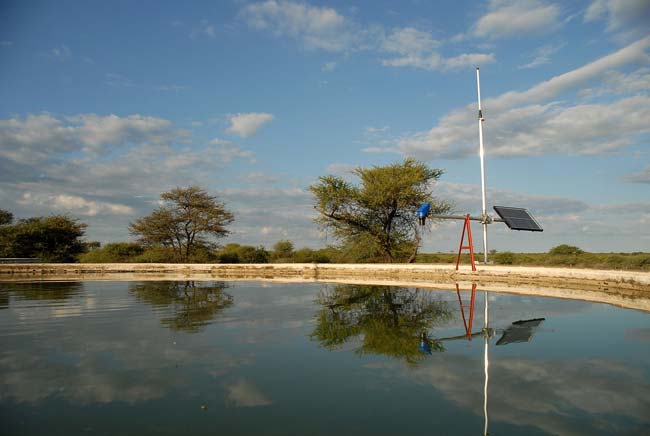Instant alerts via radio and GSM reduces maintenance, improves stock management and lowers operational costs in Namibia
 With an average rainfall of just 270 mm a year, most falling between January and April, and summer temperatures often climbing to over 35°C, Namibia is an arid country. Farms critically depend on water pumped by wind, diesel electric, solar electric or AC power from underground aquifers into surface reservoir holding tanks where it can then be distributed by pipe.
With an average rainfall of just 270 mm a year, most falling between January and April, and summer temperatures often climbing to over 35°C, Namibia is an arid country. Farms critically depend on water pumped by wind, diesel electric, solar electric or AC power from underground aquifers into surface reservoir holding tanks where it can then be distributed by pipe.
This supply of water is crucial to the wellbeing of livestock and humans. Landowners need to know the status of these boreholes and reservoirs, a particular challenge as pump and storage locations are often remote from distribution sites. Given the large, rural nature of many farms in the region, landowners often have to rely on unskilled staff to monitor and control this key aspect of running an estate.
This was the challenge facing Aloegrove, a safari lodge and cattle farm located close to Otjiwarongo, to the north of the Namibian capital Windhoek, and South East of the famed Etosha National Park. Aloegrove encompasses 8,300ha overlooking the Waterberg Plateau and a vast swathe of savannah. Of this area, 4,000ha are currently allocated for the lodge and game, with daily big cat feeding, game drives, hiking and hunting. The remaining hectares are used for farming 220 cattle which require a constant supply of water to flourish successfully.
It was essential that the land owner, Johan Doman, had a high degree of confidence that ‘all is well’ at the borehole reservoir and outlying game waterholes. The Aloegrove borehole facility is used to raise water to, and distribute from, the reservoir to both the lodge and the game waterholes. This required staff to visit the borehole three times per week to monitor water levels or provide necessary maintenance. To ease delegation of responsibility for this time-consuming activity, Johan Doman committed to the installation of remote electronic monitoring that would provide a flexible, reliable and crucially cost effective resolution to maintaining Aloegrove’s rural water supplies.
Watching the water
Aloegrove commissioned Wood & Douglas, a UK-based company which focuses on the design and manufacture of bespoke wireless solutions for data, voice and video applications, to create a wireless system that could deliver on the monitoring demands of the farm. Wood & Douglas’ Namibian-based support team, Desert Technical Solutions (DTS), brought its experience in the installation and support of wireless and monitoring infrastructures to the project.
Alan Wood, CEO, Wood & Douglas, said, “While water level monitoring is taken for granted as being a simple activity, it suddenly takes on more serious financial implications. There is the direct labour cost of the person making the journey to the reservoir, the cost of the fuel for the journey and the wear and tear on the vehicle involved. By using a radio reporting system the status of the borehole reservoir can be signalled immediately to the owner via his or her cell phone”.
As for Aloegrove’s single borehole, the need is to measure water level in an open top reservoir. As a bare minimum, a simple float ball could have been installed to switch and be signalled out once the critical level is reached. Such a device can only signal a good or bad condition and shows no trends or feedback on what is actually happening at the remote location. If the float fails to operate the land owner is blind to the looming problem with serious financial implications. Because of these concerns an ultrasonic sensor was installed at Aloegrove which can provide continuous readings of the water level.
The key problems to be overcome by the installation team at Aloegrove were the complete lack of GSM coverage or presence of AC power at the borehole. With no GSM coverage at the borehole site direct alarm signalling to a cellphone is not practical. Wood & Douglas therefore installed a local radio network from the borehole to the base station located at the lodge 6.4km away which does have good GSM coverage. Data is transmitted between the borehole and the lodge, using Wood & Douglas Orion modems, and as this link to the lodge is in the 450MHz range it does not require clear line of sight.
As there is no AC power source at Aloegrove’s reservoir a 12V DC solar based battery system was installed. Additional circuitry was provided by Wood & Douglas to reduce the standby power consumption of the monitoring electronics and radio. All this hardware has been housed in a rugged IP66 rated enclosure. This not only keeps out the weather, but enables the wiring to be protected inside the housing.
To minimise power consumption from the solar supply, the outstation only reports once per hour to the base station. This status message sent via the UHF radio link gives the current water level in the storage tank as a percentage value and also reports the solar battery status.
The base station listens to the outstation message and interprets the data. This is displayed on the base station cabinet for lodge staff to locally view. If the outstation sends a water level status message below a user preset alert trip level, or sees a low outstation solar supply or misses the hourly report message, the base station will take further action and send out the cell phone text message to Johan Doman. Johan only receives a message if something is wrong that needs urgent action. A number of repeat sendings of the GSM alert ensures confidence that the message will get through, crucial on a large farm estate where GSM coverage may at times be limited.
Freddie Groenewald, DTS, said, “The big advantage of this scenario at Aloegrove is that only the base station needs to have a GSM connection and therefore only one SIM account is needed. Despite the reservoir outstation not having GSM coverage it is not a communication issue, and we can deliver a true and current status snapshot of the estate water storage system as well as monitoring the condition of the outstation power supply. The base station has the capacity to support a large number of outstations, and what has not yet been capitalised on is that other farms in the area could also report into the Aloegrove base station and jointly share the modest infrastructure cost”.
“With the borehole radio system now in place, we are starting to see a wider variety of possibilities for the use of radio systems to make our business more cost efficient. The Wood & Douglas and DTS team understand radio and can rapidly interpret a need into a radio based reality. We have plans to use their skills and knowledge to install radio linked CCTV monitoring of our waterholes as our next investment” said Johan Doman. “With the greater efficiency afforded to the team, we are able to spend more time addressing the other needs of the estate and farm, not least the care of our guests.”



































